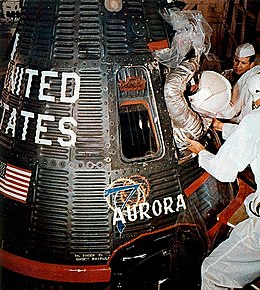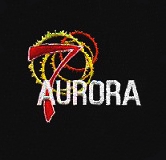 Carpenter entering his MA-7 capsule, Aurora 7 | |
| Mission type | Test flight |
|---|---|
| Operator | NASA |
| Harvard designation | 1962 Tau 1 |
| COSPAR ID | 1962-019A |
| SATCAT no. | 295 |
| Mission duration | 4 hours, 56 minutes, 5 seconds |
| Distance travelled | 122,344 kilometers (76,021 mi) |
| Orbits completed | 3 |
| Spacecraft properties | |
| Spacecraft | Mercury No.18 |
| Manufacturer | McDonnell Aircraft |
| Launch mass | 1,350.0 kilograms (2,976.2 lb) |
| Crew | |
| Crew size | 1 |
| Members | |
| Callsign | Aurora 7 |
| Start of mission | |
| Launch date | May 24, 1962, 12:45:16 UTC |
| Rocket | Atlas LV-3B 107-D |
| Launch site | Cape Canaveral LC-14 |
| End of mission | |
| Recovered by | USS Intrepid[1] |
| Landing date | May 24, 1962, 17:41:21 UTC |
| Landing site | North-east of Puerto Rico, Caribbean Sea |
| Orbital parameters | |
| Reference system | Geocentric |
| Regime | Low Earth orbit |
| Perigee altitude | 154 kilometers (83 nmi) |
| Apogee altitude | 259 kilometers (140 nmi) |
| Inclination | 32.5 degrees |
| Period | 88.63 minutes |
| Epoch | May 24, 1962[2] |

 Malcolm Scott Carpenter Project Mercury Crewed missions | |
Mercury-Atlas 7, launched May 24, 1962, was the fourth crewed flight of Project Mercury. The spacecraft, named Aurora 7, was piloted by astronaut Scott Carpenter. He was the sixth human to fly in space. The mission used Mercury spacecraft No. 18 and Atlas launch vehicle No. 107-D.
The flight was for three Earth orbits, essentially a repeat of John Glenn's Mercury-Atlas 6. However, a targeting error during reentry took the spacecraft 250 miles (400 km) off-course, delaying recovery of Carpenter and the spacecraft for an hour. Carpenter was held responsible, at least in part, for the landing error. Carpenter left NASA for the Navy SEALAB program in 1964.